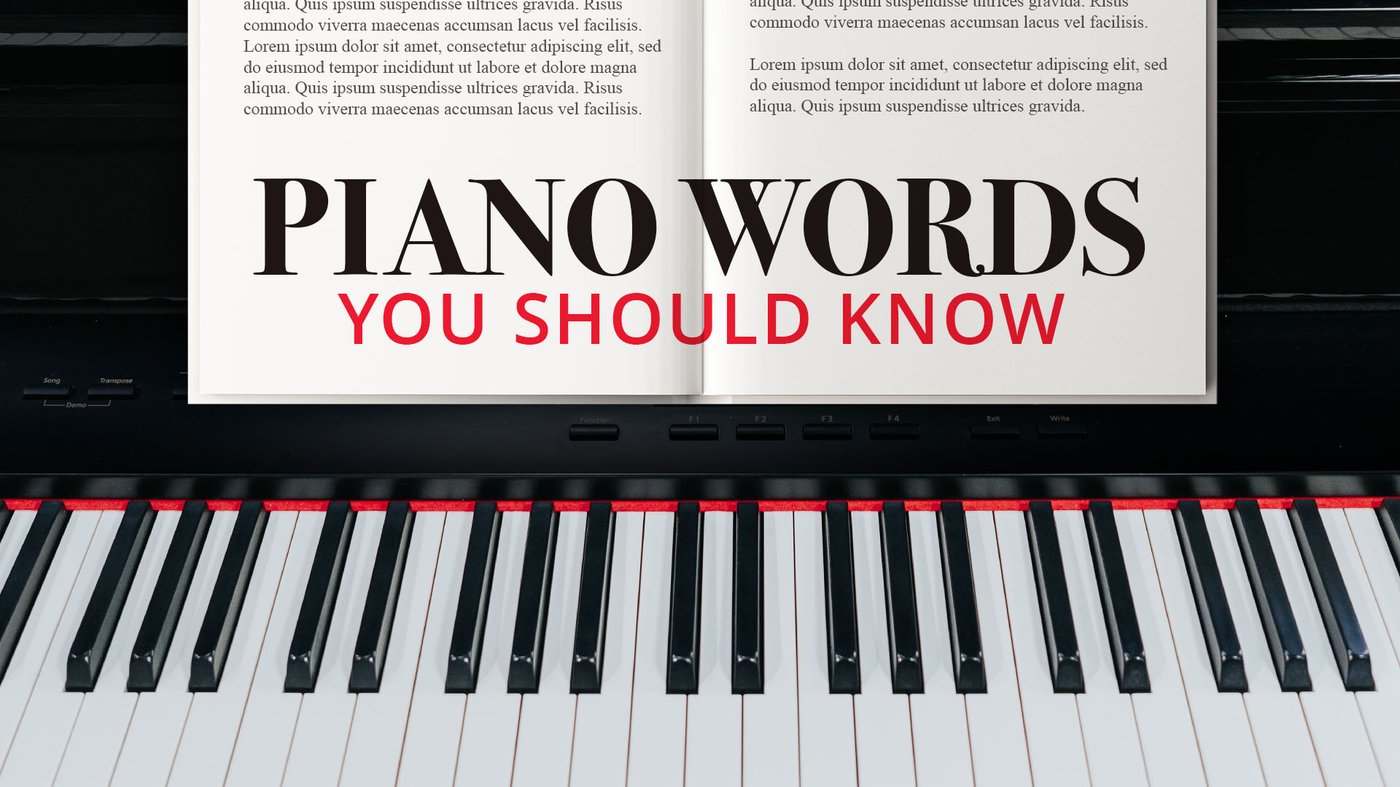
Musicians have their own language. As a piano player, you’ve likely come across words you haven’t seen anywhere else. Here is a complete glossary of common piano terms you’ll encounter throughout your musical journey.
The piano has been around for a very long time and many music terms are Italian due to Italy’s influence on classical music. However, the piano is a truly multidisciplinary instrument with a big role in genres like blues, jazz, pop, and rock. So, we’ve included piano terms here from as many musical genres as possible.
Table of Contents:
Subscribe to The Note for exclusive interviews, fascinating articles, and inspiring lessons delivered straight to your inbox. Unsubscribe at any time.
We’ve organized piano terms in alphabetical order in this glossary. You can also browse sections by clicking on topics in the Table of Contents above.
If you have a specific term in mind and are on desktop, press Ctrl+F (Cmd+F on Mac) and then type in the term in question. Your computer will find the term and highlight it.
Here’s how to do the same on mobile:
Apple
Android
Piano terms to do with how notes are played.
An acciaccatura looks like a small note before a main note with a slash through it. Acciaccaturas are played briefly as a small, passing ornament that resolves to the main note. Unlike appoggiaturas, they are not played on the downbeat. Acciaccaturas and appoggiaturas are types of grace note.
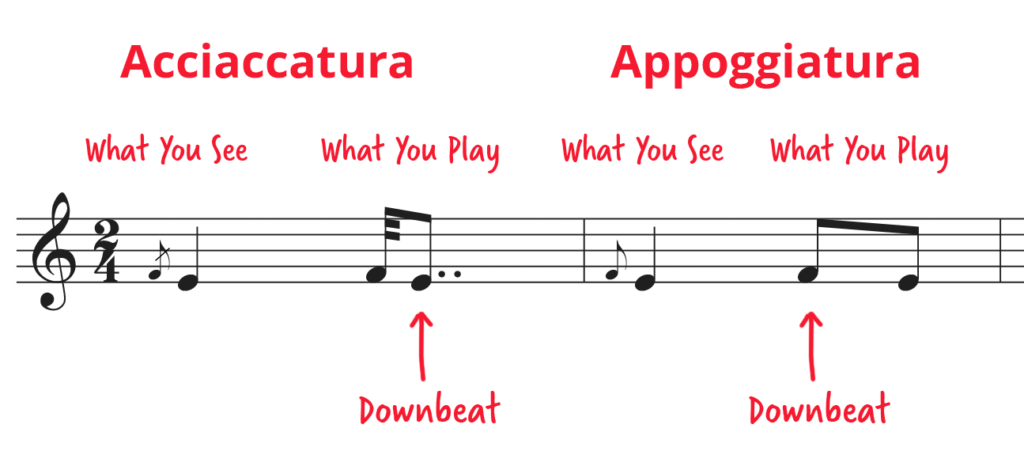
An appoggiatura looks like a small note before a main note. Appoggiaturas are brief ornaments that resolve toward the main note. Unlike acciaccaturas, appoggiaturas are played on the downbeat and get more emphasis, taking some of the note value away from the main note. Acciaccaturas and appoggiaturas are types of grace note.
A fermata resembles half a circle with a dot above or below a note or a rest. It indicates that the note should be held or sustained longer than its written value.

A glissando looks like a squiggly line between two notes, indicating sliding from one note to the other.
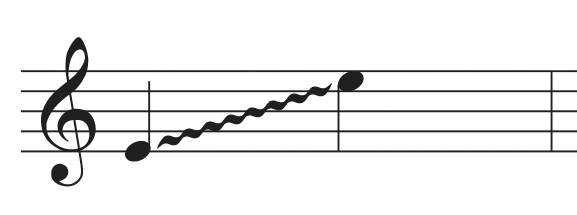
A grace note looks like a small note written right before a main one. Meant as an embellishment to the main note, it adds decorative flair and is typically performed quickly. Grace notes can be acciaccaturas or appoggiaturas.
Play smoothly and connected.
Play with a light touch.
Mordents are ornamental markings that look like short squiggly lines above notes. They are played as short trills, with variations of the mordent indicating the direction of the trill:
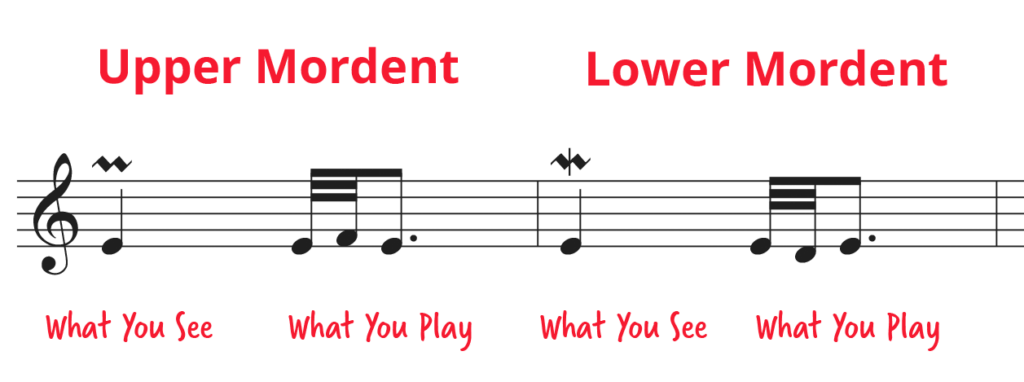
A slur is a curved line connecting two or more notes of different pitches, indicating that they should be played smoothly and without separation, creating a legato effect.

A staccato is represented by a small dot above or below a note and indicates playing in a short, detached manner.

Tenuto indicates that a note should be sustained for its full duration, receiving full value. It is often represented by a horizontal line placed above or below the note and is used to emphasize a note.

A tie is a curved line connecting two or more notes of the same pitch, indicating that their durations should be combined and played as a single note.

To tremolo means to play the note rapidly and tremolos are often used to build tension. A tremolo is indicated by diagonal lines or slashes drawn through the stem of the note having the tremolo, with the number of lines representing speed or intensity.

A trill is a rapid alternation between two adjacent notes. Trills are often represented by the letters “tr” above the note being trilled or by a long horizontal squiggly line.

A turn is represented by a sideways, S-shaped symbol above a note. It’s a quick ornamentation that involves rapidly playing the note above the main note, the main note, the note below, and back to the main note.

Words to do with dynamics (loudness and softness) and expression.
Gradually get faster.
Slowly.
In a singing style.
“With vigor.”
Gradually get louder.
Gradually get softer.
Gradually get softer.
Fun fact: Schubert interpreted “diminuendo” as meaning to gradually get softer and slow down, while “decrescendo” for Schubert just meant to get softer.
Sweetly.
Loud.
Very loud; louder than forte.
Moderately loud.
Moderately soft.
Very soft; softer than piano.
Soft.
Terms about a piece’s flow, form, and structure.
Also called strophic form, each section is set to the same music in this structure. You can think of it as a verse-chorus structure with no choruses.
Also called binary form. A two-part musical form with two contrasting sections. Common in Baroque music.
Also called ternary form. A three-part musical form with a contrasting section between two repeating or similar sections. Common in jazz.
The 12 bar blues is a common chord progression and musical form that consists of four-measure phrases using the I, IV, and V chords.
> How to Play Blues Piano: Beginner’s Guide
Also called the “tail,” the coda is a concluding section or passage at the end of a piece.
Meaning “from the head,” da capo or “D.C.” means to play from the beginning up to an indicated point in sheet music.
“Da capo al fine” means “from the beginning to the end.” Repeat from the beginning of a piece to the point where “fine” is noted.
“Da capo al coda” means to repeat the piece from the beginning to the coda symbol, after which, go to the second coda symbol and play to the end.
“Da capo al segno” means “from the beginning to the sign.” Repeat the piece from the beginning until you reach the sign symbol.
Rondo form is a musical structure consisting of a recurring theme (A) alternating with contrasting sections (B, C, D, etc.). It’s often represented as ABACA or ABACABA.
A classical form with exposition, development, and recapitulation sections, with contrasting themes and key modulations.
A structure where each section contains new material with no repeating parts.
Terms to do with specific genres of music.
The 12 bar blues is a chord progression and song structure that typically consists of 12 measures and is built on the I, IV, and V chords.
> How to Play Blues Piano: Beginner’s Guide
The Alberti bass is a type of broken chord accompaniment popular in classical music. Named after Italian composer Domenico Alberti, it involves playing a triad in a specific pattern: root, fifth, third, fifth repeatedly.
Boogie-woogie is a style of blues-based piano music characterized by a repetitive and syncopated bass line. It emerged in the early 20th century and is known for its energetic and lively rhythm.
A concerto is a musical composition that features a solo instrument or group of instruments in dialogue with an accompanying orchestra or ensemble. It typically consists of multiple movements and showcases the virtuosity and expressive capabilities of the soloist(s).
A nocturne is a composition meant to evoke nighttime. Frédèric Chopin is famous for his many piano nocturnes.
Commonly paired together, a prelude is a short introductory piece while a fugue is an intricate piece with complex counterpoint of many voices. Johann Sebastian Bach is most famous for his 48 preludes and fugues in The Well-Tempered Clavier.
Ragtime is a musical style characterized by syncopated rhythm, a steady bass line, and distinctive melodic patterns. A piano-focused genre, ragtime originated in African-American communities in the late 19th and early 20th centuries and is considered a precursor to jazz.
A sonata is a musical composition usually intended for a solo instrument. Popular in the classical era, it typically consists of multiple structured movements with contrasting themes.
In jazz, a piano trio typically consists of a piano, bass, and drums. In classical music, a piano, cello, and violin often make up a trio.
A rhythmic, steady, and continuous bass line common in blues and jazz that adds rhythm and a “walking” feel.
Piano terms that relate to the piano as an instrument.
The mechanism that translates the pressing of keys into the striking of strings, allowing control over dynamics and expression. “Action” is often used to describe how a piano feels when played.
Also known as the sustain pedal, the damper pedal is located at the very right of most pianos and is the most commonly used pedal. It lifts all the dampers from the strings, allowing notes to resonate freely.
An instrument designed to mimic the sound and playing experience of an acoustic piano. Sound in a digital piano is created through sampling or modeling.
> Keyboard vs. Piano: What’s the difference?
The piano fallboard is the hinged cover that can be opened or closed to protect the keys and internal components of the piano when not in use.
Hammers are small, felt-covered wooden devices that strike strings when a key is pressed, producing sound in an acoustic piano.
A musical interface used on piano and piano-like instruments with black and white keys. Colloquially, “keyboard” can refer to digital pianos.
> Keyboard vs. Piano: What’s the Difference?
A wooden inner component in pianos that anchors the tuning pins and plays a significant role in keeping the piano in tune.
The sostenuto pedal is the middle pedal, usually found only in grand pianos. It sustains only the notes held down at the moment the pedal is pressed, allowing selective sustain.
Typically made of spruce, the piano soundboard is a wooden resonating surface beneath the strings that amplifies and enhances the sound produced by the vibrations of the piano strings.
Also known as the damper pedal, the sustain pedal is located at the very right of most pianos and is the most commonly used pedal. It lifts all the dampers from the strings, allowing notes to resonate freely.
A synthesizer is an electronic musical instrument, often controlled by a piano keyboard, that generates and manipulates sound through oscillators, filters, and amplifiers.
Also known as the soft pedal, the una corda produces a softer, more muted tone. In a grand piano, the una corda is typically located on the left and, when pressed, shifts the entire keyboard slightly to the side, causing the hammers to strike only one of the two or three strings. On an upright piano, pressing the una corda causes a cloth cover to fall between the hammers and strings. “Una corda” means “one string.”
Terms to do with the speed of music.
Return to the original tempo.
Fast and bright.
Moderately fast; slower than allegro.
At a walking pace.
Slowly and broadly.
Similar to largo, but a little faster.
At a slow tempo.
At a moderate tempo.
Very fast.
Extremely fast; faster than presto.
Gradually slow down.
Gradually slow down.
Rit. vs. ral.: What’s the difference between rallentando and ritardando? If we look at the original Italian, ritardando implies more deliberate effort while rallentando implies a more natural dying-off of speed.
“Robbed time.” Push and pull at the tempo to create expression.
Fast and lively.
Terms to do with music theory.
Aeolian mode is a scale whose formula (based on the major scale) is 1-2-♭3-4-5-♭6-♭7. You can think of the Aeolian mode as starting and ending a scale on the sixth degree of the major scale. The Aeolian mode is equal to the relative natural minor scale.
> Piano Scales: Types of Scales & How to Apply Them
“Augmented” means “larger.” An augmented interval is a major interval that has been increased by a half step. Augmented chords contain an augmented interval. For example, a C augmented triad contains the notes C-E-G#, where C-G# is an augmented fifth interval.
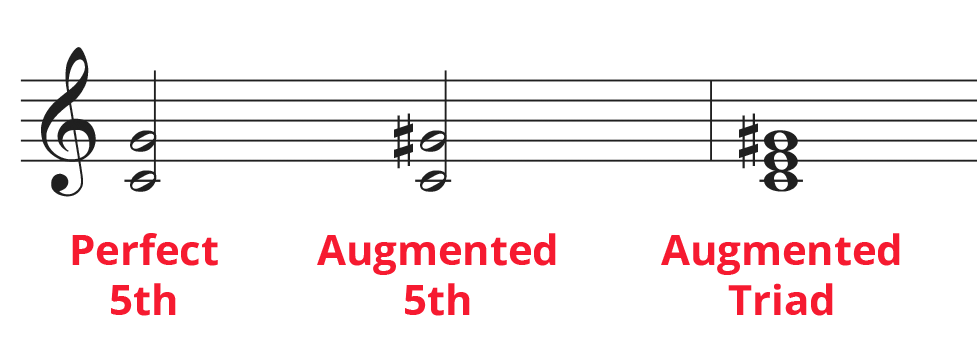
The blues scale is a six-note scale. “Blues scale” usually refers to the minor blues scale, which has the following formula: 1, ♭3, 4, ♭5, 5, ♭7.
> The Blues Scale Formula: Theory & Diagrams
Chord extensions are additional notes beyond the basic triad (root, third, and fifth) that are added to create richer and more complex harmonies.
> How to Play All Piano Chords: Chord Extensions
The chromatic scale consists of all twelve pitches in an octave, ascending or descending by half steps.
Intervals and chords that naturally occur on a given scale are said to be “diatonic.” For example, the major third interval D-F# is diatonic to D major, but not diatonic to C major because F# does not occur in the C major scale.
A diatonic chord is a chord built entirely out of notes that occur naturally in a given scale.
“Diminished” means “smaller.” A diminished interval is a minor interval that has been decreased by a half step. Diminished chords contain a diminished interval. For example, a C diminished triad contains the notes C-E♭-G♭, where C-G♭ is a diminished fifth interval.
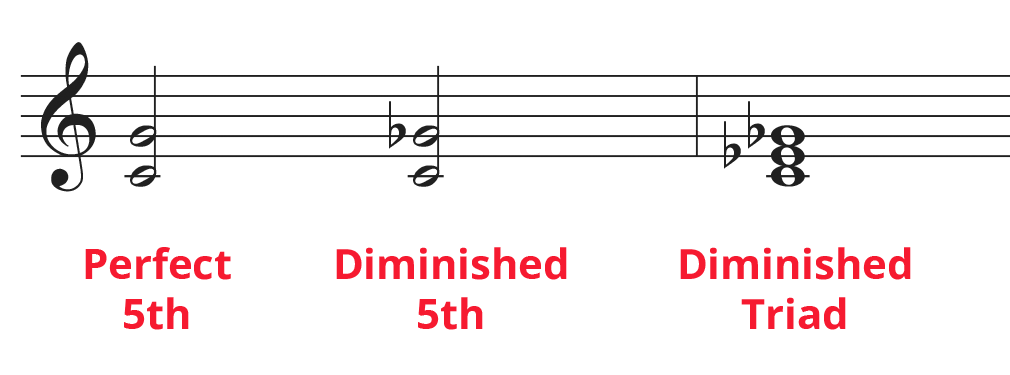
A Diminished 7th chord consists of a diminished triad and a diminished seventh interval. It can also be thought of as a stack of minor thirds.
> Ultimate Guide to 7th Chords on Piano
The fifth note of the scale. The dominant of C major is G.
A dominant 7th chord is built on the fifth note of the scale and follows the key signature of that scale. It consists of a major triad and a minor seventh interval.
> Ultimate Guide to 7th Chords on Piano
Dorian mode is a scale whose formula (based on the major scale) is 1-2-♭3-4-5-6-♭7. You can also think of Dorian mode as starting and ending a scale on the second degree of the scale.
> Piano Scales: Types of Scales & How to Apply Them
“Enharmonic” refers to equivalent pitches that are named differently, such as C-sharp and D-flat.
The flat symbol looks like a lowercase “b.” It means to lower a note by one half step.

A half-diminished 7th chord is a minor 7th chord with a flatted fifth. It consists of a diminished triad and minor seventh. For example: C-Eb-Gb-Bb.
> Ultimate Guide to 7th Chords on Piano
A “half step” or “semitone” is the smallest interval in Western music, equivalent to the distance between two adjacent keys on a piano keyboard.
The harmonic minor scale is a minor scale that contains a raised seventh note.
The distance between two notes.
Ionian mode is a scale whose formula (based on the major scale) is 1-2-3-4-5-6-7. Therefore, the Ionian mode is equivalent to the major scale. You can also think of Ionian mode as starting and ending the major scale on its first degree.
> Piano Scales: Types of Scales & How to Apply Them
Key refers to the tonal center of a piece of music. It determines the scale, chords, and overall harmonic framework of a piece.
The key signature is a set of sharp or flat symbols at the beginning of a piece of music, indicating the piece’s key.
Seventh note of the scale. The leading tone of C major is B.
Locrian mode is a scale whose formula (based on the major scale) is 1-♭2-♭3-4-♭5-♭6-♭7. You can also think of Locrian mode as starting and ending the major scale on the seventh degree.
Lydian mode is a scale whose formula (based on the major scale) is 1-2-3-#4-5-6-7. You can also think of Lydian mode as starting and ending the major scale on the fourth degree.
> Piano Scales: Types of Scales & How to Apply Them
Third note of the scale. The mediant of C major is E.
The melodic minor is a minor scale variation that raises the sixth and seventh degrees up one half step when ascending, but lowers them back down to the natural minor when descending.
Mixolydian mode is a scale whose formula (based on the major scale) is 1-2-3-4-5-6-♭7. You can think of Mixolydian mode as starting and ending the major scale on the fifth degree.
A mode is a scale with a specific pattern of whole and half steps that give it a distinct tonal character and mood.
> Piano Scales: Types of Scales & How to Apply Them
The natural symbol looks like a square with jutting sides. When placed before a note, it cancels any previous sharp or flat alterations, restoring the note to its natural, unaltered pitch.

A passing tone is a non-chord tone that connects two chord tones.
Pentatonic scales are five-note scales. The major pentatonic scale consists of the major scale degrees 1, 2, 3, 5, and 6. The minor pentatonic scale consists of the major scale degrees 1, ♭3, 4, 5, and ♭7.
Phrygian mode is a scale whose formula (based on the major scale) is 1-♭2-♭3-4-5-♭6-♭7. You can think of Phrygian mode as starting and ending the major scale on the third degree.
Relative major and minor scales share the same key signature but start and end on different notes and have different tonal centers.
A scale is a sequence of musical pitches played in ascending or descending order, often following a specific pattern of whole and half steps.
> Piano Scales: Types of Scales & How to Apply Them
Scale degree refers to the position of a note within a scale. For example, G is the fifth scale degree (or “dominant”) in the C major scale.
A chord outside the key of a given piece, which is the dominant (V) chord of the chord it is resolving towards. For example, if our piece is in C major, the E7 in the following progression is a secondary dominant because it is the dominant 7th chord in the key of A.
E7 – Am – C
Raise a note up by one half step.

Fourth degree of the scale. F is the subdominant of C major.
Sixth degree of the scale. A is the submediant of C major.
Second degree of the scale. D is the supertonic of C major.
The tonal center is the main or central pitch within a piece or key. It serves as a point of stability, focus, and resolution. For example, the tonal center of a piece in C major or the C major scale is C.
First degree of the scale. C is the tonic of C major.
A triad is a three-note chord that consists of a root, third, and fifth.
Also known as a diminished 5th or augmented 4th, a tritone is an interval of three whole steps. It’s often considered dissonant and unstable, and is commonly used to create tension in music.
A “whole step” or “whole tone” is an interval that spans two half steps or two semitones. It is equivalent to the distance between two keys one key apart on the piano keyboard.
Inspiring tutorials. Fascinating articles. Exclusive interviews. We create piano content anyone, anywhere can enjoy for free. Don’t miss out, sign up for more free lessons.
Pianote is the Ultimate Online Piano Lessons Experience™. Learn at your own pace, get expert lessons from real teachers and world-class pianists, and join a community of supportive piano players. Learn more about becoming a Member.
/marketing/pianote/lead-gen/getting-started/coach.webp)
/marketing/pianote/lead-gen/getting-started/logo.webp)
By signing up you’ll also receive our ongoing free lessons and special offers. Don’t worry, we value your privacy and you can unsubscribe at any time.
We use cookies for traffic data and advertising. Cookie Policy »